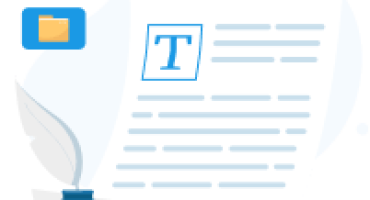Writing a Literature Review: General Guidelines
Table of contents
Writing a literature review for a research paper is an important stage in the academic research process. It entails doing a critical review of existing literature to provide a comprehensive overview of current knowledge on a certain issue. In this article, we will walk you through the important processes for writing an excellent literature review. We’ll discuss how to discover relevant literature, combine findings, and arrange your review to provide clear insights. Whether you’re a seasoned researcher or a first-time writer, this guide will give you essential advice and tactics for improving the quality and impact of your literature reviews.
What Is a Literature Review?
A literature review is a survey of key scholarly sources to do with a particular topic. It lists a number of important and relevant pieces of writing and, in doing so, gives the reader a summary of the topic’s current knowledge and debates. When writing a literature review, a student should do more than just summarise each individual source. They should analyze them closely and compare them with one another.
A key part of academic writing involves understanding what has been said and debated about the chosen topic. Once a student has done their research, they’re in a better place to write their research paper and put their point across. A good literature review should let the reader know what the salient points from the student’s research are.
What Is the Purpose of a Literature Review?
The purpose of a literature review is to show the reader what research has been carried out on the chosen topic in the past. When writing one, you’re aiming to bring the reader up to speed with other people’s research before sharing your own findings. You should summarise where the topic’s at right now before building on it with your research.
Another important purpose is to give more weight to a student’s key arguments. By listing and comparing some of the key sources, a student can give context to the main points in their research paper; they can even fill any gaps in certain areas that others haven’t yet managed to fill.
If you want to know how to write a literature review in a research paper, carry on reading. We’ll run you through the process of putting one together, and we’ll talk about some of the different approaches you can take in writing one.
Steps in the Literature Review Process
A literature review can make a Ph.D. dissertation, or any other kind of research paper more convincing. For a review to be effective, it should be detailed and have substance but without overdoing it; in other words, it should be concise.
If you’re not sure how to write a literature review for a research paper, we’ll show you how in this section. Here are the main steps to take:
- Decide on your topic
Your topic is the base on which you build your research. It also determines what research you carry out. - Search for sources to include
The sources you look at for your research paper should be authoritative and relevant. They should be scholarly in nature, though not all of them will be. - Determine which ones are the most useful
Look through your sources and think about how much each one adds to both the topic you’re exploring and the research you’re carrying out. Including all sources isn’t practical, so only choose the most appropriate and fitting ones. - Identify where the research is currently at
By reading other people’s research, you can get an idea of what the current thoughts and debates relating to your chosen topic area. - Come up with a structure
Literature reviews have quite simple structures. More information on these is given below. Think about how you want to present yours and how you’re going to arrange your findings. - Write your literature review
A well-written literature review gives the reader all the necessary information about each of the sources. It clearly explains how the sources are connected and what they contribute to the chosen topic.
It’s a good idea to come up with headings and subheadings and go from there. These are both important, and we’ll talk about them in more detail later on. During the planning process, they can help you come up with a definitive structure for your literature review and consolidate your thoughts.
You may want to pay someone to write a literature review for you. Many people who are struggling with literature reviews do this. They don’t hand in the work that someone else has done for them. Instead, they read through the other person’s work to get ideas and inspiration. Doing this can help people write their own literature review much more effectively.
- Free unlimited checks
- All common file formats
- Accurate results
- Intuitive interface

How to Structure a Literature Review
For this section, we’ll look at how to write a literature review. We’ll focus on the different approaches you can take according to the type of research you’re doing and how you wish to present it.
Chronological
Listing your sources in chronological order is perhaps the simplest approach to take. However, make sure you don’t just list the sources and summarise them. You should still try to establish some sort of connection between them. Highlight movements, patterns, and new ideas. Show the reader how scholarship on the topic has changed over time. You could even organize your sources into broad historical periods and have these as subheadings in the literature review, for example.
Thematic
When writing a thematic literature review, you should organize your sources by theme. You should consider this approach if you’ve found multiple themes during your research. Create literature review subheadings for each theme that stands out to you. If you go for a thematic style, think about what your RRL subtopics are and what themes you would use to organize them.
Methodological
A methodological literature review is one whose sources involve the use of different research methods. You could have one source that’s numerical and involves graphs and statistics, for example, and another that’s entirely made up of written text. The subheadings in a literature review that’s methodological could focus on different types of research, focusing not so much on what has been researched but how it’s been researched. As a literature review subheadings example, you could therefore have one subheading for literary sources, another for numerical/graph-based data, and so on.
Theoretical
With a theoretical approach, the focus is on the body of theories relating to the topic that’s being discussed. The aim is to determine what theories there currently are, how they relate to one another, and how much they’ve been looked into.
These are just some of the different ways you can go about writing a literature review. The approach you take will depend on the nature of your review and the topic you’re looking at.
Writing a literature review can be an intimidating task to tackle, especially if you are not familiar with the literature in the field. Fortunately, there is a paper writing service online that can help you create an outstanding literature review in no time. Our service is helpful for students, researchers, and others who need to compile a comprehensive and informative literature review.

Literature Review Outline
Writing a good outline for a literature review is important for your research paper. It helps you organize your thoughts and ideas and gives you a clear direction for the writing process.
An outline is not a formal document but rather an informal guide to assist you in organizing the information you want to include in your paper. The outline should be written in paragraph form, with each paragraph representing one major idea that will be expanded upon in subsequent paragraphs of the paper.
The main purpose of writing an outline is so that you can organize all of your sources in a way that will help you write a clear, concise essay. You just want to throw together quotes and facts without any order or reason. This will make it hard for the reader to follow along with what you are saying and make it appear that you have no idea what you’re talking about. This can result in a low grade for your paper and make it difficult for them to understand what is happening within the text.

- Introduction
The introduction should include a brief summary of the literature that is being reviewed, including the general topic and your specific focus. You should also provide some background information on the topic to help the reader understand why it is important. You should not include any citations in this section, because you will do that later in the paper. - Body
The body is where you provide an overview of all the sources or literature, you have used for your paper. You should include an introduction to each source and a brief summary of what was found in each source. In addition to providing summaries, you should also describe how each source relates to your research question or hypothesis and then relate them back to each other if they are similar enough to be compared. Finally, you should explain how each source relates to one another in addition to explaining how they relate to your research question or hypothesis. - Conclusion
The conclusion should summarize your arguments throughout the paper and then tie all of these things together into one coherent argument that proves or disproves your hypothesis or research question in relation to other sources discussed throughout this paper (and/or).
Writing a literature review is an integral part of a successful research article or dissertation, as it helps to synthesize and connect the existing body of knowledge. To write your lit review relevantly, it is important to ensure that you include new information when constructing your review and connect existing ideas and themes. A useful literature review outline can provide a structure for expressing your views, allowing you to connect and organize your ideas consistently and effectively.
Literature Review: Writing Tips
When writing a literature review, it’s important to include all of the information your assignment requires. Sometimes, instructors will give you specific guidelines for how long your literature review should be and how many sources it needs to include. If they don’t, however, you’ll need to decide what works best for your situation.
A literature review outline will be the foundation of your paper. It will tell you what information is important and how to write it cohesively and logically. When writing, it’s important to only include facts backed up by evidence. This means that if you are writing about any research topic, there must be at least one piece of published work that backs up each claim or opinion you present.
If there isn’t a source supporting your writing, don’t put it in because it makes your paper seem like speculation or opinion rather than fact-based knowledge about the issue at hand. Another tip for writers is to write clearly and concisely so that readers can understand what they are reading quickly without having any difficulty following along from one point to another throughout the entire essay (or book).
Readers may get bored very quickly if they feel like they have to struggle through something too much before getting into where things go next. Therefore, proper grammar usage should also be kept while doing this type as well, so there are no mistakes left behind after editing later down the line during the publishing stage itself.
The following are the most important tips for writing a literature review:
- Make sure that each paragraph covers a single subject or idea.
- Start with a thesis statement, which should sum up the paper’s main idea in one sentence.
- Write each paragraph in a way that flows from one point to another logically and coherently.
- Include quotes and paraphrases from sources you have read in order to support your arguments and conclusions.
- Make sure that you use credible sources as evidence for your claims and arguments in your paper.

As well as learning how to write a literature review for a research paper, you’ll learn to be more productive and use your time more wisely. Writing services help you put together literature reviews more efficiently. They give you the opportunity to work with an experienced writer who can offer tips in writing RRL, help you with literature review formatting, and more. For example, you can even get things like literature review headings and subheadings so you can see how best to write your headings.
Remember that while the literature review isn’t the main part of a research assignment, it’s still significant. It’s important that you write it as best you can so that your research has more backing and will be taken more seriously.





